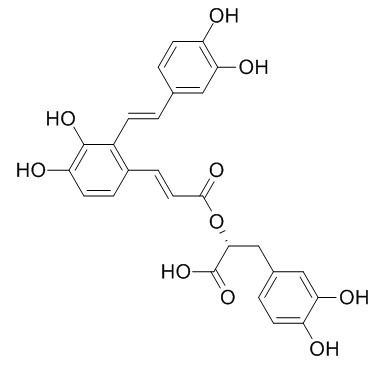Natural Products
Salvianolic acid A
| Catalog No. | CFN99161 |  |
| CAS No. | 96574-01-5 | |
| Molecular Weight: | 494.45 | |
| Molecular Formula | C26H22O10 | |
| DBs | [PubChem]:274951257 [ChEMBL]:9017 [PCIDB]:2772 |
Standard InChI:
InChI=1S/C26H22O10/c27-18-7-2-14(11-21(18)30)1-6-17-16(4-9-20(29)25(17)33)5-10-24(32)36-23(26(34)35)13-15-3-8-19(28)22(31)12-15/h1-12,23,27-31,33H,13H2,(H,34,35)/b6-1+,10-5+/t23-/m1/s1
Biological Activity
Salvianolic acid A (SAA), the water-soluble phenolic acids in Salvia miltiorrhiza, has protection against cerebral lesion, defense from oxidative damage and improvement of remembrance; it also has antithrombotic effect, antiplatelet action and can modulate hemorheology without affecting coagulation system, the mechanisms underlying such activities may involve the induction of cAMP.[1]
Salvianolic acid A possesses antioxidant activity, also has a significant protective effect against isoproterenol-induced myocardial infarction; it activates the Nrf2/HO-1 axis in RPE cells and protects against oxidative stress via activation of Akt/mTORC1 signaling. [2,3]
Salvianolic acid A (oral) can significantly improve glucose metabolism and inhibit oxidative injury as well as protect against impaired vascular responsiveness in STZ-induced diabetic rats.[4]
Salvianolic acid A has protection on oxidative stress and liver injury induced by carbon tetrachloride in rats, which may mainly be related to its antioxidative effect.[5
Salvianolic acid A inhibits platelet activation via the inhibition of PI3K, and attenuates arterial thrombus formation in vivo, suggests that SAA may be developed as a novel therapeutic agent for the prevention of thrombotic disorders.[6]
Salvianolic acid A is a novel matrix metalloproteinase-9 inhibitor, can prevents cardiac remodeling in spontaneously hypertensive rats.[7]
Salvianolic acid A inhibits PDGF-BB-activated HSC proliferation, partially through apoptosis induction, it exerts no direct cytotoxicity on primary hepatocytes and HSC-T6 cells under experimental concentrations. [8]
Product
Official website: Salvianolic acid A
Japanese website: Salvianolic acid A
Chinese website: Salvianolic acid A
Japanese website: Salvianolic acid A
Chinese website: Salvianolic acid A
References
[1] Fan H, Fu F, Yang M, et al. Thromb Res, 2010, 126(1):17-22.
[2] Wang S B, Tian S, Fan Y, et al. Eur J Pharmacol, 2009, 615(1-3):125-32.
[3] Zhang H, Liu Y Y, Jiang Q, et al. Free Radical Biol Med, 2014, 69(4):219-28.
[4] Wang S B, Yang X Y, Tian S, et al. Life Sci, 2009, 85(13–14):499-504.
[5] Wu Z M, Wen T, Tan Y F, et al. Basic Clinl Pharmacol Toxicol, 2007, 100(2):115-20.
[6] Z. S. HUANG †, C. L. ZENG †, Zhu L J, et al. J Throm Haemost, 2010, 8(6):1383-93.
[7] Jiang B, Li D, Deng Y, et al. Plos One, 2013, 8(3):e59621-e59621.
[8] Lin Y L, Lee T F, Huang Y J, et al. J Pharm Pharmaco, 2006, 58(7):933-9.
[9] Wang Z, Xu Y, Jiao R, et al. China Pharmacist, 2014(09):1473-5.
Product Use Citation





